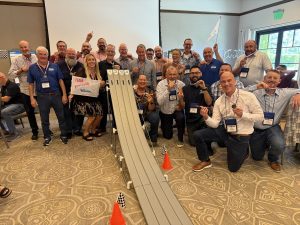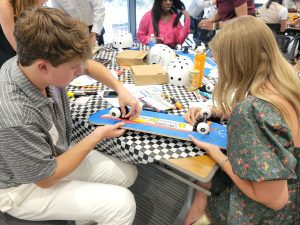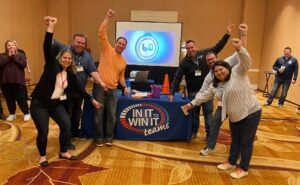Lifelong learning isn’t just a buzzword—it’s a fundamental shift in how we approach professional development and employee engagement. That doesn’t mean it’s complicated to implement, though.
We all learn something new every day! Whether it’s a small tidbit like how to use a feature on the copier or a big insight about ourselves, engaging in continuous learning is an important part of growing as a person and a professional.
In our podcast episode, Learning Style Savviness, we spoke with Hall of Fame speaker and team building expert, Tyler Hayden. We discussed employee engagement, learning styles, and—most importantly—the importance of continuous learning.
What Is Lifelong Learning?
First things first—what is lifelong learning? As the name suggests, it refers to the process of constantly working to expand your knowledge and skill sets throughout your life. Lifelong learners are always learning new things to apply to their lives and work.
Continuous learning in the workplace is particularly important—it’s all too easy to become complacent in your career.
If you have a good job and the skills necessary to fulfill that role, why would you want to expend the effort to learn more knowledge you don’t really need? Why not put that time toward your hobbies or relaxing?
The trick is to circumvent this mindset. Lifelong learners are the driving force behind sustainable business success, whether your team is mastering new technologies, developing leadership skills, or striving toward innovation.
It’s essential for leaders to encourage continuous learning through experience sharing, team building, and programs tailored to their team’s learning styles.
Understanding Different Learning Styles in the Workplace
As Hayden pointed out in our discussion, the trick to engaging your team and capitalizing on the benefits of lifelong learning in the workplace is considering your team’s learning styles. He said:
“Recognizing and designing for employee learning styles—including kinesthetic, interpersonal, and linguistic—can enhance engagement, reduce absenteeism, and align team activities with business goals.
“By tailoring experiences to the different types of learning styles, organizations can create more effective, measurable, and meaningful development opportunities.”
Ultimately, it makes perfect sense. After all, focusing on different learning styles allows teachers in school to engage students, break down barriers, and help each child reach their full potential.
A Quick Overview of Common Learning Styles
In our podcast episode, Hayden shared practical strategies for accommodating different learning styles in the workplace using his Multiple Intelligence Quotient (MIQ) framework.
Here’s a quick overview of the three learning styles he focuses on the most:
- Kinesthetic: Kinesthetic learners process information best through physical movement, touch, and hands-on experiences. In other words, they need to learn by doing rather than listening to or reading information.
- Interpersonal: Interpersonal learners excel in social environments, learning through interaction, collaboration, and relationships with others. They have the easiest time processing information when they talk it through with others.
- Linguistic: Linguistic learners have a strong affinity for words, language, and verbal communication. They process information best through reading, writing, and verbal expression.
Understanding and applying these styles can help you select and design inclusive, effective learning experiences that will reach your entire team. In contrast, ignoring them leads to favoring only those who learn in “traditional” ways.
It’s important to take a multi-modal approach to team building for this very reason, which is something we specialize in here at TeamBonding. It ensures that each person can engage in ways that feel natural to them while still pushing themselves in other areas
Benefits of Lifelong Learning at Work
There are many benefits of encouraging continuous, shared learning experiences at work. Much like professional development, learning at work can help better your employees and business as a whole.
Plus, employees pick up all sorts of useful knowledge and skills in the process.
To really underline the importance of constant learning at work, let’s take the time to look at some of the biggest benefits.
Invests In Employees’ Futures
The top benefit of encouraging lifelong learning through shared experiences for your team is that you’re investing in your employees’ futures. It may sound simple, but this single act introduces numerous benefits of its own:
- Improved reputation: Treating your team well and fostering their future careers improves your brand’s reputation with both customers and prospective employees.
- Increased loyalty: Investing in your employees boosts team loyalty, which in turn can lead to improved retention rates.
- Higher motivation: Helping your team learn also creates a pipeline of more motivated, skilled employees who will seek out new skills and chances to grow together.
- Better prospects: When your business gets a reputation for taking care of its employees, finding highly qualified candidates and retaining them becomes easier as well.
Employees are your greatest asset. They’re what drives your business towards success. More knowledgeable and skilled employees mean increased productivity, efficiency, creativity, and innovation—all of which give you a leg up on the competition.
An investment in an employee today will pay dividends weeks, months, or years later.
Increases Employee Confidence & Productivity
Another benefit is that employees engaged in continuous learning via shared experience tend to have higher confidence and productivity. They work best when they feel cared about and valued, and prioritizing their growth is an effective way to do that.
This resulting increase in confidence has its own benefits:
- Prevent negative behaviors: Confident and engaged employees are less likely to engage in resenteeism or coffee badging.
- More new ideas: Confident and productive employees are also more likely to present new ideas during brainstorming sessions.
- Greater effort: Finally, your team will also be more motivated and excited to give projects their all because they believe in their potential, both individually and together. They’ll work as hard as they can to help a company achieve its goal.
Overall, a workplace that focuses on learning will have a stronger, more knowledgeable, and motivated workforce that is more productive, creative, and pushes a business forward to success.
Helps You Adapt To Sudden Changes
Lastly, fostering lifelong learners in your workplace can help you, your employees, and your business adapt to sudden changes. Change is inevitable, and while we’re often reluctant to change, embracing it is essential.
When your employees dedicate themselves to lifelong learning, it becomes easier for them to get used to change. It also helps them gain new skills that can help them deal with change, which future-proofs your business.
All of this goes to show you shouldn’t underestimate the importance of continuous learning in the workplace. With all the various benefits, it’s clear that a culture of continual learning should be standard in every business.
How to Foster Lifelong Learning in the Workplace
A significant part of our discussion with Hayden focused on fostering a mindset of continuous learning in the workplace. He shared a great deal about creating learning experiences that stick, with a significant focus on learning environments and styles.
“Good team building is good team learning,” he said, “and when we’re able to provide a great learning environment that aligns with the people in the room, then we can start to move the needle within the organization.”
It’s much easier to understand why continual learning is important in the workplace than it is to know how to foster it. That said, there are many different strategies and techniques you can use to create a culture of learning.
Just remember, every employee is different and has their own style of learning. You may need to tailor programs or strategies to your employees to have maximum impact.
Below, we’ll highlight some of our top tips to help you foster an attitude of lifelong learning in the workplace.
1. Don’t Punish Failure
Possibly the most important tip to promoting continuous learning is not to punish failure. Failure is a necessary part of learning and growth. Punishing employees for failure discourages them from learning and growing.
After all, if they’re aware that they might be punished for making mistakes, why would they take the risks needed to learn in the first place? The goal of learning is to improve your life, not to get punished by your leader.
So, if you want to help an employee become a continuous learner, you should value failures! They’re an opportunity to learn more, and they should be used to reflect and continue learning and growing.
Our lives are journeys of continual learning powered by what we learn from our mistakes and failures. Often, it takes us decades to really understand how to learn from them.
Many of the greatest teachers believe that we don’t become good students until we’re well into adulthood, when we’ve learned the value of failure and moved past proclivities toward perfectionism.
Remember, failure is necessary for growth! Let your employees fail—encourage them to take risks! When you help them learn from those mistakes instead of punishing them, you’ll be amazed at the growth your team experiences.
2. Make Time for Learning
If you want employees to keep learning, you need to set aside time for it. That means taking a break from the daily grind for team building and learning experiences.
This may seem incredibly obvious, but it’s all too easy to overlook—many leaders forget that learning is a conscious effort that takes time.
Sure, you might tell employees they need to learn in their off hours, but people have lives! They have families, hobbies, and interests they aren’t going to sacrifice just to learn a new sales tactic or marketing strategy.
And that’s okay. It’s natural.
Instead of this unrealistic expectation, give employees opportunities to learn during the workday. They will be much more receptive and likely to engage in learning opportunities if it’s during their typical working hours.
E-learning and in-person classes can both be easily offered at work.
3. Reward Innovation & Risk-Taking
Another good strategy to encourage learning is to reward innovation. When you do this, your employees will actually want to learn new things—they will strive to innovate.
As simple as it is, a good reward is almost always an effective motivator in the workplace.
Employee incentive programs can be incredibly effective here. For example, a program that rewards employees for taking classes outside of work can have a huge impact on how many employees engage in continual learning.
Outside of that, it also shows employees that you value them and are willing to reward their efforts. This has numerous benefits in and of itself, like increased retention and engagement.
4. Foster Shared Learning Experiences
One last strategy to consider is fostering shared learning experiences. These can be incredibly impactful and are one of the best examples of continuous learning in the workplace. Here are some examples of potential shared learning programs:
- Team Leadership DNA: This event helps employees identify their own strengths and weaknesses, as well as those of their team members. It helps boost teamwork, leadership, communication, and more through shared learning.
- Team Resilience Training: By learning about techniques together to improve resiliency—such as maintaining wellness and proper sleep hygiene—you can encourage your team to become more resilient and start prioritizing ongoing learning.
- Effective Communication: Communication is key in any business, especially in ones that prioritize learning. This event helps teams get tools and insights to communicate more directly and effectively.
These are just some of many options. At TeamBonding, we offer over 200 programs in our suite of events, all designed to emphasize learning, growth, and bonding. We’ll also customize them for your specific goals and your team’s many learning styles.
Promote Continuous Learning with TeamBonding
Lifelong learning is the process of constantly improving your skills and gaining new knowledge throughout your life. Creating a pro-learning environment can help increase productivity, retention, your reputation, employee wellbeing, and much more.
The crew here at TeamBonding has over 25 years of experience in the field, and we’ve found that one of the best ways to promote learning in the workplace is with team building events!
Countless companies have partnered with TeamBonding to promote continual learning in the workplace to great effect.
Get in touch with us today to find out how we can help your team become lifelong learners! We’re ready to get started when you are.

















